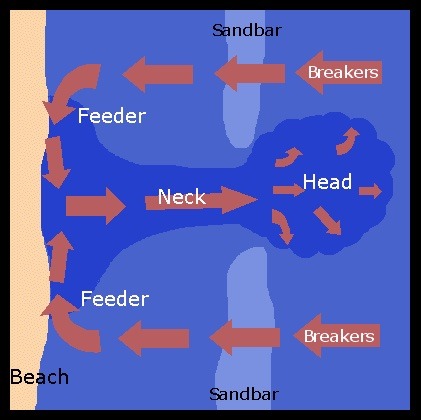Rip Currents
Rip currents in Florida are serious. They’re one of the biggest dangers at Florida beaches, and are a leading cause of beach drownings and emergency rescues.
Thankfully, the dangers of rip currents can be reduced with simple knowledge:
- What they are, and how they work
- How to spot warning signs
- How to escape them safely
- What to do if someone is caught in a rip current
What is a rip current?
Rip currents are powerful, narrow channels of fast-moving water, which flow away from land. They can be thought of as a narrow river of water, flowing out to sea.

Rip currents are strongest near the water surface, and move directly away from the shore.
Rip currents can be fast, and powerful. They can flow faster than an Olympic swimmer can sprint. This makes them dangerous to swimmers, who can be pulled away from the shore quickly and unexpectedly.
Sadly, many swimmers panic, or exhaust themselves by trying to swim against the currents, which is difficult or impossible.
Where do rip currents form?
Most people associate rip currents with ocean waters, but rip currents can form at any beach with breaking waves, including large lakes.
Rip currents form when waves break strongly in some places and weaker in others. This can happen near piers, jetties, and sandbars, or in gaps between these structures.
Strong breaking waves push water up onto the shore. Then, the water flows back into the ocean in a concentrated narrow path, creating a rip current. These currents can quickly pull swimmers into deeper water away from the shore.
Rip currents can form along any beach in Florida, including:
- Beaches in the Panhandle
- Beaches on Florida’s Gulf Coast
- Beaches in the Florida Keys
- Beaches on the East Coast
How to identity a rip current
Knowing how to identify these signs can help you choose the safest place to swim. To spot rip currents, look for these signs:
- Areas of “smooth water”, where waves aren’t breaking as they come to shore. This may indicate a deeper channel of water, where water will flow back out to sea and away from land.
- A difference in the color of the water – often murkier or darker, suggesting a deeper channel.
- Foam, seaweed, or floating debris moves out to sea, possibly signal the presence of a rip current.
- A break in the incoming wave pattern could show where the rip current is flowing.
- The presence of sandbars are a clue that rip currents may form.
Note: Rip currents can appear, change, and disappear, quickly — even within minutes!
Avoid Rip Currents
- Always try to swim at beaches with lifeguards.
- Look for and read the beach safety signs and lifeguard signs. They may have warnings about rip currents.
- Check the local beach forecast for rip current warnings before you go into the water.
- Learn how to spot rip currents (look for the signs we talked about before).
- Talk to lifeguards. They can tell you about the water conditions and where it’s safest to swim.
- Never swim in or near dangerously strong waves, especially waves from a storm or hurricane.
What to do if you’re in a rip current
If you’re caught in a rip current, it’s important to:
- Stay calm to conserve energy. Try to relax, and think clearly.
- Never try to swim against the rip current. It’s too strong and you’ll become exhausted.
- Float and tread water instead. This will help you save energy and keep your head above water.
- Swim parallel to the shoreline. This is often the quickest way to get out of the rip current.
- If you can’t escape, keep floating and signal for help by waving your arms and yelling.
Rip currents are powerful but they’re usually very narrow. Once you’re out of the current, swimming back to shore is easier.
If you see someone caught in a rip current
- Call for help immediately. Alert lifeguards or call 911.
- Yell and motion to tell them to swim parallel to the shore.
- Don’t swim out to them because you will get caught in the current too. Many people drown while trying to help others.
- When help arrives, direct them to the person’s location.
Knowing about rip currents can help you stay safe and make smarter choices in the water.
More resources on rip currents can be found on Weather.gov
